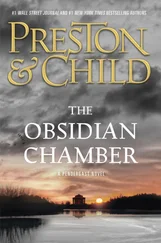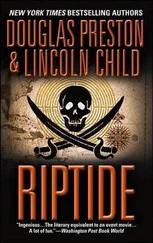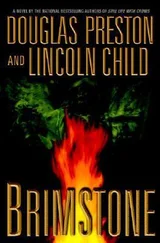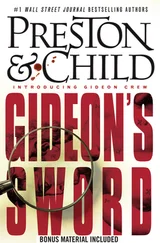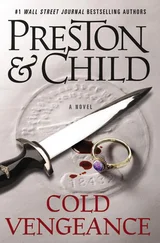D’Agosta hesitated a moment. This was not the Heffler whom D’Agosta was familiar with: the glossy, supercilious prick in a thousand-dollar suit. This Heffler was rumpled, tired, and had the look of a man who had recently been called on the carpet.
He launched into his rehearsed speech anyway. “Dr. Heffler, we’ve been waiting over sixty hours —”
“Yes, yes!” Heffler said. “And I’ve got the results. They just came in. We’ve been working on it since three this morning.”
A silence. Heffler’s manicured fingernails eagerly tapped a file on his desk. “It’s all right here. And please allow me to apologize for the delay. We’ve been understaffed—these budget cuts—you know how it is.” He flashed D’Agosta a look that hovered somewhere between sarcasm and a simper.
Hearing all this, D’Agosta felt the wind go right out of his sails. Someone had already gotten to Heffler. Was it Singleton? He paused, took a breath, and tried to shift down. “You have the results on both homicides?”
“Absolutely. Please, Lieutenant, sit down. I’ll go over them with you.”
Grudgingly, D’Agosta took the proffered chair.
“I’ll just summarize, but please feel free to interrupt if you have questions.” Heffler opened the file. “The DNA sampling was excellent, the team did a great job. We have solid DNA profiles from hair, latents, and of course the earlobe. All match to a very high degree of certainty. We can confirm that the earlobe did indeed belong to the perpetrator.”
A page turned. “For the second homicide, we also have solid DNA profiles from hair, latents, and the fingertip. Again, all three match each other and the DNA profiles from the first homicide. The finger and earlobe came from the same individual—the killer.”
“How certain are the results?”
“Very certain. These were excellent profiles with abundant, uncontaminated material. The possibility of this being coincidence is less than one in a billion.” Heffler was already starting to recover some of his own self-assurance.
D’Agosta nodded. This was nothing new, really, but it was good to have confirmation. “Did you run it against the DNA databases?”
“We did. Against every database we have access to. No hits. That isn’t surprising, of course, since the vast majority of people don’t have their DNA in any database.”
Heffler closed the report. “This is your copy, Lieutenant. I’ve transmitted the master file electronically to the chief of homicide, the homicide analysis unit, and the central investigation and resource division. Is there anyone else who should get it?”
“Not that I can think of.” D’Agosta rose, picked up the file. “Dr. Heffler, when Captain Singleton called you, did he mention we also wanted mtDNA analysis?”
“Well, no, because Captain Singleton didn’t call me.”
D’Agosta looked Heffler in the face. Somebody had definitely kicked this son of a bitch in the ass, and he wanted to know who. “ Someone must have called you.”
“The commissioner.”
“The commissioner? You mean Tagliabue? When?”
A hesitation. “At two o’clock this morning.”
“Oh, yeah? What did he say?”
“He informed me this is a very important case and that even the slightest problem might be, ah, career ending.”
A beat.
And now Heffler smirked. “So good luck, Lieutenant. You have the results you wanted. You’ve got quite a killer on your hands—let’s hope you don’t have a… problem.”
The smile indicated he very much hoped the opposite.

12
AT FIRST GLANCE, THE LIBRARY AT MOUNT MERCY HOSPITAL for the Criminally Insane looked like the typical reading room of any gentlemen’s club: dark, polished wood; baroque fixtures; discreet lighting. Closer examination, however, revealed certain unique differences. The wing chairs and wooden refectory tables were immovable, having been screwed to the floor. No sharp objects or heavy, blunt implements were to be seen. The magazines being browsed by the inmates all had their staples removed. And at the room’s single entrance stood a muscular man wearing an orderly’s uniform.
Dr. John Felder sat at a small round table in a far corner of the library. He was fidgeting with his hands, clearly nervous.
There was movement at the entrance, and he glanced over quickly. Constance Greene stood in the doorway, accompanied by a guard. She looked around, saw him, and came over. She was dressed modestly, in a white pleated skirt and a blouse of the palest lavender. In one hand she held a letter; in the other, an airmail envelope.
“Dr. Felder,” she said in her courtly voice as she sat down across from him. She placed the letter inside the envelope and turned it facedown on the table, but not before Felder noticed that the letter seemed to contain only one word. It was in a strange script, Sanskrit or Marathi or something similar.
He looked from the letter to Constance. “Thank you for seeing me,” he replied.
“I did not expect you to return so soon.”
“Neither did I. I beg your pardon. It’s because…” He stopped, glanced around to make sure they were not being overheard. Despite being reassured, he lowered his voice. “Constance, I’m finding it very difficult to get on with things, knowing that… that you don’t trust me.”
“I don’t understand why that should vex you. I’m simply an ex-patient—no doubt one of many.”
“I’d like to find some way I could make it up to you.” Felder was unused to talking about his feelings, especially to a patient, and he felt himself flush with both embarrassment and shame. “I don’t expect to treat you in the future—I respect your wishes in that regard. It’s just that I wish… well, that I could somehow compensate for what happened… for what I did. Make it right. So you could trust me again.”
These last words tumbled out in a rush. Constance looked at him, her violet eyes cool and appraising. “Why is this important to you, Doctor?”
“I…” He realized he didn’t really know why. Or hadn’t examined his feelings closely enough to see.
For a long moment, the table was silent. Then Constance spoke. “Some time ago, you told me you believed I was, in fact, born on Water Street in the 1870s.”
“I did say that once, yes.”
“Do you still believe it?”
“It… it seems so bizarre, so difficult to comprehend. And yet I have found nothing to contradict you. In fact, I’ve found independent evidence to support what you say. Also, I know you’re not a liar. And when I examine the clinical issues— really look at them—I wonder if you suffer from any psychotic condition at all. You may be emotionally troubled, true, and I’m sure there’s some past trauma that continues to haunt you. But I just don’t believe you’re delusional. And I increasingly doubt if you even threw your child off that ship. Your note to Pendergast seemed to indicate the baby was still alive. I feel like there’s something going on here, some ruse or perhaps larger plan, which has yet to be uncovered.”
Constance went still.
When she said nothing, he continued. “All circumstantial evidence, of course—but highly persuasive. And then, there’s this .” He extracted his wallet, opened it, and pulled out a small piece of paper. He unfolded it and passed it to Constance. It was a photocopy of an old newspaper engraving, depicting an urban scene of dirty-faced children playing stickball on a tenement street. Standing to one side was another child, thin and frightened, broom in her hand. She was an almost photographic likeness of a young Constance Greene.
Читать дальше


